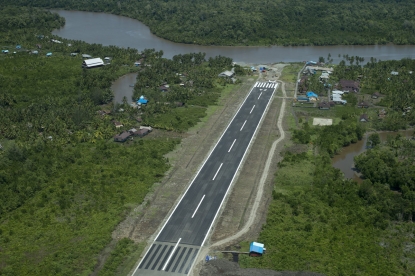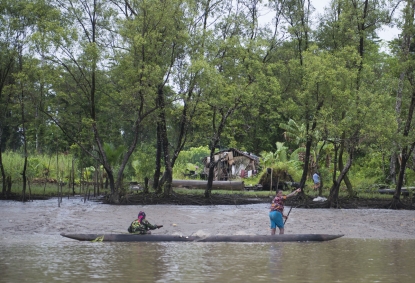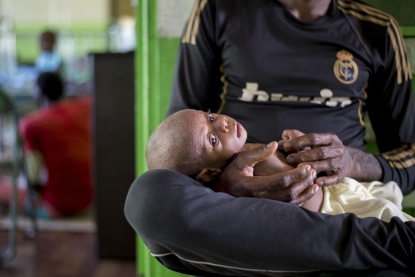A skeleton wrapped in skin
Asmat, Papua, Indonesia -- The three-year-old skeleton wrapped in skin should otherwise have been a little girl. She was barely breathing, fighting for her life in a remote part of the jungle, as her parents helplessly looked on. I have seen plenty of extreme poverty in my seven years as a journalist in Indonesia. Never have I seen a child in such a state.
The trip that took me to her started out in the usual whirlwind fashion. Six hours after covering the US secretary of defense’s visit to Indonesia in the lavish halls of the presidential palace in Jakarta, I was on a seven-hour overnight flight to Papua with colleagues from text and photo.
We were headed to cover one of the most haunting stories any of us had yet experienced, and we were nervous because it was already saturated with firsts.
For the first time we were allowed to travel deep into Papua, to a remote region that normally has been off limits to Western journalists like us. When President Joko Widodo came to power in 2014, he adopted a more liberal approach in an effort to attract more foreign investment and ordered, among other things, that access to Papua be allowed for Western news outlets.
It took a while for the new approach to trickle down on the ground. But eventually it did -- when news began to spread in recent months that a measles outbreak in one of the most remote corners of Papua had killed dozens of children, the army invited us to go along with them to the area. We would become some of the first Western journalists to see the place in decades, and the army would get coverage of what it was doing to help the local population.
The trip offered another bonus -- usually Western journalists aren’t allowed anywhere near military installations. So much so that I can’t even go to the military airport to shoot the arrival of hostages freed in the Philippines, or the return of civilians’ bodies arriving from a disaster zone.
And now here I was, embedded with the army and, eventually, actually flying in one of their helicopters. But more on that later.
First, a brief explanation of Papua's history. It's on the second largest island in the world -- New Guinea -- sitting just above the northern coast of Australia.
During the European colonial era, New Guinea was split in half: the eastern part belonged to the Germans and then the British and Australians and the western side was under Dutch rule.
Today, the island is still split in half, but the eastern side gained independence and became Papua New Guinea, while the Dutch side was taken over by Indonesia decades ago and became Papua province.
Papuans are distinctly different from other Indonesians, both culturally and in their genetic makeup, sharing more with Melanesians who are spread out across islands in the Pacific. Many West Papuans today consider themselves an occupied people (part of the reason it was closed to Western reporters for so long). There is a heavy Indonesian military presence as a low-level separatist insurgency burns on an island that is rich in natural resources but has a population so poor that some are actually starving to death.
 A member of an Indonesian military task force checks child at a local hospital in Agats, the capital of Asmat district in Indonesia's easternmost Papua province, on January 26, 2018.
(AFP / Bay Ismoyo)
A member of an Indonesian military task force checks child at a local hospital in Agats, the capital of Asmat district in Indonesia's easternmost Papua province, on January 26, 2018.
(AFP / Bay Ismoyo)Our night flight from Jakarta landed in Timika. We then hopped onto a seatless Cessna 208 Caravan prop plane, which gave us another thrill of sorts. Up until then, most of the stories that we had covered in Papua had been crashes of planes just like this, small seatless little birds of metal gliding over some of the world’s densest jungle cover. When we got on and saw that the plane had only one pilot, we exchanged glances and smiled (we were all thinking the same thing). “Let’s just hope we don’t become the story,” we said and settled in for the ride. To be honest, any fear we may have had was far outweighed by excitement. In today’s world, there are very few places where one can go and be “the first.” This was one of them -- we’d be among the first Westerns to see this corner of the globe in decades.
The plane glided over dense tropical jungle, which is one of Indonesia's last untouched forests (deforestation in Indonesia is the most rampant in the world). The thick network of large rivers below us served both as water supply for its thriving wilderness, but also as the only means of connection between villages in the remote region.
The pilot flew low for us so that we could get good aerial shots of the place, and after about an hour we landed in Agats - the tiny capital of Asmat district, the epicenter of the measles outbreak where the deaths of dozens of toddlers was causing untold grief for their parents.
 The airport in Agats. (AFP / Bay Ismoyo)
The airport in Agats. (AFP / Bay Ismoyo)“My personal last frontier,” I thought as I got off the plane and took a look around. “Impenetrable, wild and far away. I’ve finally made it to the heart of Papua!”
To call Asmat extremely isolated is a bit of an understatement. The “airport” consisted of a strip of concrete and a shack. The entire region lies next to a river, the main way of getting around from village to village, on ground so swampy that everything is on stilts -- from shacks to paths. There are no cars.
Even though it’s only about 100 miles (160 kilometres) away from Timika -- the gateway to one of the world's biggest mines operated by US-based Freeport -- to get to Asmat one has to use either a small chartered plane (which would cost $2,000-3,000 to book), fly a commercial plane which doesn’t operate daily, or travel by boat which would take about 10 hours. In short, it's expensive to travel to Asmat. Not many people can afford this kind of travel and so the outside world often doesn't know what’s going on here.
 Fishing in Agats. (AFP / Bay Ismoyo)
Fishing in Agats. (AFP / Bay Ismoyo)We headed to the hospital as soon as we landed. If you could call it as such. It is the sole major medical facility for the entire Asmat district and is supposed to service nearly 130,000 people living in dozens of tiny villages along the river (A few tiny clinics in some villages are barely worthy of the name, staffed by overwhelmed nurses and no doctors). There is no lab. No operating room.
One young girl was lying on the ground in an exterior hallway. Her legs were thinner that the stand for an IV that was keeping her alive. A few metres from her head someone had parked a motorbike. Her eyes were open, but she was staring at nothing. I kept looking at the motorbike, parked so close to her head. “That’s just not right,” I kept thinking. “There shouldn’t be a motorbike parked next to her head.”
"The hospital is full, so we had to move so many children to the church," we were told. So after the hospital we went to the church.
It was quickly becoming apparent that the measles outbreak wasn’t the only story. The underlying story here was malnourishment. These people are so poor that some are literally starving to death. A malnourished child will succumb to measles more easily than a well-fed one.
 A Papuan man holds his child at a local hospital handling measles and malnutrition patients in Agats, the capital of Asmat district in Indonesia's easternmost Papua province, on January 25, 2018.
(AFP / Bay Ismoyo)
A Papuan man holds his child at a local hospital handling measles and malnutrition patients in Agats, the capital of Asmat district in Indonesia's easternmost Papua province, on January 25, 2018.
(AFP / Bay Ismoyo)The people living here, the Asmat tribe, are unlucky in that they are caught in between two worlds. They are descendants of people who used to live in the jungle, getting their food and medicine from it. They no longer do that. They now live in “villages” -- collections of feeble bamboo huts on stilts on the banks of the river.
Now most of their food consists of instant noodles that are brought in by boat to little “convenience stores” called “warung.” The only problem is that there are hardly any jobs. It’s hard to buy food when you have no money.
That reality came screaming out to us in a room by the hospital's entrance, where a father and mother stared down at a skeleton tightly wrapped in human skin. It was their three-year-old daughter, still breathing.
In my seven years working as a journalist in Indonesia, I have seen extreme poverty like this before. But never had I seen children in such condition. It just hit me in the stomach. It was a very physical reaction -- I just wanted to throw up. I suppose it would have been even worse if I had been a parent. In moments like this -- when I witness something truly terrible -- my camera becomes my shield. It becomes a filter, protecting you from the reality in front, so that I can do my job and shoot the scene. And that’s what I did. I shot that skeleton wrapped in skin that was supposed to be a three-year-old girl. And despite that shield, that image will stay with me for a long, long time.
I wasn’t the only one shaken by it. Lots of colleagues from other news organizations later told me that that particular image is what prompted them to follow in our footsteps and report on the story as well.
Sending the harrowing footage took more than 14 hours with our satellite device. From 4:00 pm till seven the next morning I stared at my laptop while it did its best to upload my video. Something that in normal conditions would've taken less than 20 minutes. After that, it was time to go back out and shoot some more.
We spent the next day on tiny speedboats racing down the rivers, following the Indonesian military as it visited a remote village on stilts.
In all, we spent four nights in the region, but it will be a trip that I will remember for a long time. Flying out marked another first -- we flew out aboard a chopper of the military that wouldn’t allow us anywhere near its installations for years. But that’s not what will stay with me. It will be the image of that little girl, clinging to life. We checked up on her before leaving. She was still alive, but her battle with death was nowhere near being over. I hope she made it in the end. It would soften a bit that image of her seared in my memory.
 Homes in Asmat.
(AFP / Bay Ismoyo)
Homes in Asmat.
(AFP / Bay Ismoyo)



